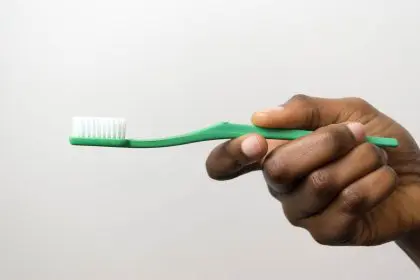Bad breath affects nearly everyone at some point, yet many people experience persistent halitosis despite maintaining good dental hygiene practices. Understanding why brushing alone may not eliminate bad breath requires examining the various underlying causes that extend beyond simple food particle accumulation on teeth and gums.
Research indicates that 80 to 85 percent of bad breath cases originate from oral causes, while the remaining cases stem from factors outside the mouth. This distinction becomes crucial for determining appropriate treatment approaches when standard oral hygiene measures prove insufficient for eliminating persistent breath odors.
Bacterial hiding places resist standard cleaning methods
Cavities in teeth create protected environments where odor-causing bacteria can accumulate beyond the reach of standard brushing techniques. These hollow spaces allow bacteria to multiply and produce sulfur compounds that contribute to bad breath, even when other areas of the mouth receive thorough cleaning.
Similarly, gum disease creates deep pockets between teeth and gums where bacteria can establish colonies that resist removal through regular brushing and flossing. These periodontal pockets require professional cleaning to eliminate bacterial accumulation effectively.
The inability of standard oral hygiene to reach these hidden bacterial reservoirs explains why some people experience persistent bad breath despite conscientious dental care. Professional dental treatment becomes necessary to address these underlying structural problems.
Saliva production affects bacterial control
Dry mouth conditions significantly impact breath freshness by reducing saliva production that normally helps control bacterial levels and wash away food particles. Saliva serves multiple functions including breaking down food, facilitating swallowing, and maintaining optimal bacterial balance within the oral environment.
When salivary glands produce insufficient saliva, bacteria multiply more readily and create increased sulfur compound production that causes bad breath. Dry mouth also elevates risks for tooth decay and gum disease, creating additional sources of breath odor.
Medications, tobacco use, and alcohol consumption commonly contribute to dry mouth conditions that persist despite regular brushing. Addressing these underlying causes becomes essential for managing associated bad breath problems effectively.
Digestive disorders create internal odor sources
Gastroesophageal reflux disease produces bad breath through stomach acid and undigested food regurgitation that creates odors originating from the digestive system rather than the mouth. GERD also causes heartburn and bitter taste sensations that accompany breath odor problems.
The digestive nature of GERD-related bad breath means that oral hygiene measures alone cannot eliminate the odor source, requiring medical treatment of the underlying reflux condition. Dietary modifications and appropriate medications typically provide more effective relief than increased brushing frequency.
Understanding that some bad breath originates from digestive processes helps explain why thorough oral care may not resolve persistent breath problems that require medical rather than dental intervention.
Systemic health conditions affect breath quality
Various health conditions including diabetes, kidney failure, liver failure, peptic ulcers, and intestinal blockages can cause bad breath through chemical changes in the bloodstream or alterations in body bacteria levels. These systemic causes create breath odors that originate from internal metabolic processes.
The connection between general health and breath quality demonstrates how oral symptoms can reflect broader health issues requiring medical evaluation and treatment. Dental hygiene measures cannot address these underlying medical conditions that contribute to persistent breath problems.
Recognition of systemic health influences on breath quality emphasizes the importance of comprehensive health assessment when bad breath persists despite adequate oral care practices.
Food compounds circulate through bloodstream
Certain foods including onions and garlic create persistent breath odors that continue even after thorough tooth brushing because aromatic compounds enter the bloodstream and reach the lungs. These volatile oils can affect breath quality for 24 hours or more following consumption.
The systemic circulation of food-derived compounds means that oral hygiene cannot eliminate these odors, which must be metabolized and eliminated through normal body processes. Some foods including raw apples, lettuce, and mint leaves may help neutralize garlic breath more effectively than brushing alone.
Understanding the biochemical basis of food-related bad breath helps explain why certain odors persist despite thorough oral cleaning and why dietary awareness becomes important for breath management.
Respiratory conditions contribute to oral bacteria
Postnasal drip from sinus infections, colds, flu, or strep throat creates mucus accumulation that attracts bacteria and produces breath odors. The mucus provides nutrients for bacterial growth while creating environments that promote odor-producing bacterial metabolism.
Respiratory conditions affecting nasal and sinus areas can significantly impact breath quality through bacterial colonization of mucus secretions that reach the throat and mouth. These bacteria produce compounds that create bad breath despite adequate oral hygiene practices.
Treatment of underlying respiratory conditions often provides more effective bad breath relief than increased oral hygiene frequency when postnasal drip represents the primary contributing factor.
Tobacco use creates multiple odor pathways
Smoking produces bad breath through direct tobacco smoke residue on breath as well as through mouth drying effects that promote bacterial growth. Tobacco use also increases gum disease risk, creating additional bacterial reservoirs that contribute to persistent breath odors.
The multiple mechanisms by which smoking affects breath quality mean that smoking cessation often provides more dramatic improvement than enhanced oral hygiene alone. Tobacco cessation addresses both direct smoke odors and secondary effects on oral health.
Understanding smoking’s complex effects on breath quality helps explain why smokers often experience persistent bad breath problems that require tobacco cessation rather than just improved dental care.
Home remedies provide additional treatment options
Baking soda rinses offer cost-effective alternatives to commercial mouthwashes while providing antibacterial effects that complement standard oral hygiene. Mixing 2 teaspoons of baking soda with 1 cup of warm water creates an effective mouth rinse for 30-second use.
Increased water consumption helps address dry mouth conditions that contribute to bad breath by maintaining oral moisture levels and supporting natural saliva production. Sugar-free gum chewing can also stimulate saliva release to combat dry mouth effects.
Natural remedies including pineapple juice consumption and fennel seed chewing provide traditional approaches to breath freshening that some people find effective as supplements to standard oral hygiene practices.
Professional evaluation determines appropriate treatment
Persistent bad breath despite good oral hygiene warrants dental evaluation to identify underlying causes such as gum disease, cavities, or dry mouth conditions that require professional treatment. Dentists can provide deep cleaning procedures and identify structural problems contributing to bacterial accumulation.
Treatment approaches vary depending on underlying causes, with gum disease requiring professional cleaning, GERD needing medical management, and systemic health conditions requiring appropriate specialist care. Accurate diagnosis becomes essential for effective treatment planning.
The complexity of bad breath causes demonstrates why professional evaluation provides more effective solutions than attempting to manage persistent symptoms through increased oral hygiene alone, particularly when multiple contributing factors may be present simultaneously.
Effective bad breath management requires understanding that oral hygiene represents just one component of comprehensive treatment approaches that may need to address underlying medical conditions, lifestyle factors, and structural dental problems to achieve lasting improvement in breath quality and overall oral health.

















